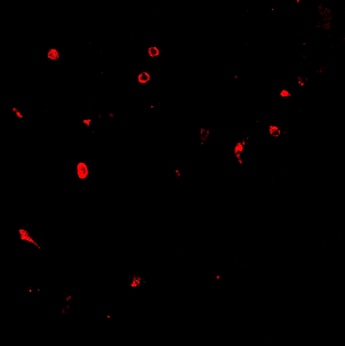Human E-Selectin/CD62E Antibody Summary
Applications
Please Note: Optimal dilutions should be determined by each laboratory for each application. General Protocols are available in the Technical Information section on our website.
Scientific Data
 View Larger
View Larger
E‑Selectin/CD62E in Human Kidney Cancer Tissue. E-Selectin/CD62E was detected in immersion fixed paraffin-embedded sections of human kidney cancer tissue using Goat Anti-Human E-Selectin/ CD62E Polyclonal Antibody (Catalog # BBA18) overnight at 4 °C. Before incubation with the primary antibody tissue was subjected to heat-induced epitope retrieval using Antigen Retrieval Reagent-Basic (Catalog # CTS013). Tissue was stained (brown) and counterstained with hematoxylin (blue). View our protocol for Chromogenic IHC Staining of Paraffin-embedded Tissue Sections.
 View Larger
View Larger
E-Selectin/CD62E in LPS treated Human Kidney Tissue. E-Selectin/CD62E was detected in acetone fixed cryosections of human kidney tissue using Goat Anti-Human E-Selectin/CD62E Polyclonal Antibody (Catalog # BBA18) overnight at 4 ° C. Tissues were stained with rabbit anti-goat secondary antibody and HRP polymer-conjugated anti-rabbit IgG followed by AEC+Substrate Chromogen (red) followed by counterstaining with hematoxylin (blue). Before incubation with the primary antibody, tissues were treatedex vivowith LPS and also treated to block endogenous peroxidase activity. The lower panel shows an absence of labeling when primary antibody is omitted. Experiments were carried out and images were provided by Dr. Grietje Molema, University of Groningen, The Netherlands.
Reconstitution Calculator
Preparation and Storage
- 12 months from date of receipt, -20 to -70 °C as supplied.
- 1 month, 2 to 8 °C under sterile conditions after reconstitution.
- 6 months, -20 to -70 °C under sterile conditions after reconstitution.
Background: E-Selectin/CD62E
E-Selectin (Endothelial Leukocyte Adhesion Molecule-1, ELAM-1, CD62E), a member of the Selectin family, is a 107 - 115 kDa cell surface glycoprotein. It is transiently expressed on vascular endothelial cells in response to IL-1 beta and TNF-alpha, and demonstrates peak expression at 4 hours, and decay at 24 hours, in response to activation. E-Selectin ligands, expressed on neutrophils, monocytes, and a subset of memory T cells, are sialylated, fucosylated molecules which bind to the lectin domain of E-Selectin. Immunocytochemical techniques have demonstrated the expression of E-Selectin on healthy and diseased tissue. The human and mouse
E‑Selectin proteins share 81% amino acid similarity.
E-Selectin mediates the attachment of flowing leukocytes to the blood vessel wall during inflammation by binding to E-Selectin ligands on leukocytes. These interactions are labile and permit leukocytes to roll along the vascular endothelium in the direction of blood flow. This initial interaction is followed by a stronger interaction involving ICAM-1 and VCAM-1 that leads eventually to extravasation of the white blood cell through the blood vessel wall into the extracellular matrix tissue.
ELISA techniques have shown that detectable levels of soluble E-Selectin are present in the biological fluids of apparently normal individuals. Furthermore, a number of studies have reported that levels of E-Selectin may be elevated in subjects with a variety of pathological conditions.
Product Datasheets
Citations for Human E-Selectin/CD62E Antibody
R&D Systems personnel manually curate a database that contains references using R&D Systems products. The data collected includes not only links to publications in PubMed, but also provides information about sample types, species, and experimental conditions.
10
Citations: Showing 1 - 10
Filter your results:
Filter by:
-
Bone vascular niche E-selectin induces mesenchymal–epithelial transition and Wnt activation in cancer cells to promote bone metastasis
Authors: Mark Esposito, Nandini Mondal, Todd M. Greco, Yong Wei, Chiara Spadazzi, Song-Chang Lin et al.
Nature Cell Biology
-
E-selectin-targeting delivery of microRNAs by microparticles ameliorates endothelial inflammation and atherosclerosis
Authors: Shuangtao Ma, Xiao Yu Tian, Yunrong Zhang, Chaofeng Mu, Haifa Shen, Jean Bismuth et al.
Scientific Reports
-
Plasticity-related gene 5 promotes spine formation in murine hippocampal neurons.
Authors: Coiro P, Stoenica L, Strauss U, Brauer A
J Biol Chem, 2014-07-29;289(36):24956-70.
-
Outer membrane vesicles derived from Escherichia coli up-regulate expression of endothelial cell adhesion molecules in vitro and in vivo.
Authors: Kim J, Yoon Y, Lee J, Choi E, Yi N, Park K, Park J, Lotvall J, Kim Y, Gho Y
PLoS ONE, 2013-03-14;8(3):e59276.
Species: Human
Sample Types: Cell Lysates
Applications: Western Blot -
Activation of endothelial TLR2 by bacterial lipoprotein upregulates proteins specific for the neutrophil response
Authors: Kevin Wilhelmsen, Kailin R Mesa, Arun Prakash, Fengyun Xu, Judith Hellman
Innate Immunity
-
ERK5 protein promotes, whereas MEK1 protein differentially regulates, the Toll-like receptor 2 protein-dependent activation of human endothelial cells and monocytes.
Authors: Wilhelmsen K, Mesa K, Lucero J, Xu F, Hellman J
J Biol Chem, 2012-06-15;287(32):26478-94.
Species: Human
Sample Types: Cell Lysates, Whole Cells
Applications: Cell-based ELISA, Western Blot -
Endothelial adhesion molecule expression is unaltered in the peripheral nerve from patients with AIDS and distal sensory polyneuropathy.
Authors: Fenzi F, Rossi F, Rava M, Cavallaro T, Ferrari S, Rizzuto N
J. Neuroimmunol., 2006-07-20;178(1):111-6.
Species: Human
Sample Types: Whole Tissue
Applications: IHC-P -
Trafficking pathways and characterization of CD4 and CD8 cells recruited to the skin of humans experimentally infected with Haemophilus ducreyi.
Authors: Humphreys TL, Baldridge LA, Billings SD, Campbell JJ, Spinola SM
Infect. Immun., 2005-07-01;73(7):3896-902.
Species: Human
Sample Types: Whole Tissue
Applications: IHC-P -
TNFalpha increases the inflammatory response to vascular balloon injury without accelerating neointimal formation.
Authors: Miller AM, McPhaden AR, Preston A, Wadsworth RM, Wainwright CL
Atherosclerosis, 2004-12-23;179(1):51-9.
Species: Rabbit
Sample Types: Whole Tissue
Applications: Neutralization -
E-selectin and ICAM-1 are incorporated into detergent-insoluble membrane domains following clustering in endothelial cells.
Authors: Tilghman RW, 2019, Hoover RL
eaav5562, 2002-08-14;525(1):83-7.
Species: Human
Sample Types: Cell Lysates
Applications: Western Blot
FAQs
No product specific FAQs exist for this product, however you may
View all Antibody FAQsReviews for Human E-Selectin/CD62E Antibody
Average Rating: 4 (Based on 1 Review)
Have you used Human E-Selectin/CD62E Antibody?
Submit a review and receive an Amazon gift card.
$25/€18/£15/$25CAN/¥75 Yuan/¥2500 Yen for a review with an image
$10/€7/£6/$10 CAD/¥70 Yuan/¥1110 Yen for a review without an image
Filter by:


